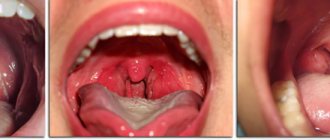A sore throat
14.07.2017
52.8 thousand
35.4 thousand
6 min.
4
Sore throat when swallowing is the most common symptom of colds and signals the development of an inflammatory process.
The organs of the mouth, throat, and nose are closely interconnected and the development of the inflammatory process in one focus quickly spreads to the entire group of organs. This is facilitated by the unification of the oro- and nasopharynx with the help of the pharyngeal ring, which acts as the main immune organ.
Pain in the throat area, extending towards the ears, can be caused not only by inflammation, but also by the development of an infectious process.
Diseases with sore throat radiating to the ears:
- Otitis.
- Eustachite.
- Pharyngitis.
- Tonsillitis.
- ARVI.
- Angina.
- Infectious diseases: diphtheria, chicken pox, scarlet fever, measles.
- These diseases have different etiologies, so the clinical picture may differ significantly.
Otitis is characterized by the development of an inflammatory process in the middle ear; as a rule, with otitis, the throat and ear hurt on one side. Otitis media can occur in several forms:
- Spicy. The disease begins with the appearance of acute pain in the area of one ear, the spread of the process to nearby tissues leads to a feeling of discomfort when swallowing. In the absence of timely treatment, it can develop into subacute, chronic or purulent forms.
- Subacute. It has no clear boundaries and easily develops into an acute or chronic course. In this case, an increase in temperature is not observed or does not differ significantly from normal.
- Chronic. In this case, the temperature rises above normal only in the evening or does not rise at all. The patient complains of weakness, painful sensations when swallowing, which radiate to the ear.
- Purulent. The most dangerous form can lead to partial or complete hearing loss. The purulent form is accompanied by acute pain and fever.
This disease is most often the reason why the throat hurts when swallowing, radiates to the ears, but there is no fever.
The cause of pain in the ear in this case is inflammation of the Eustachian tubes. The Eustachian tube is involved in the process of inflammation in diseases of the throat: tonsillitis, pharyngitis, laryngitis, etc. Swelling of the inflamed tissues causes compression of the Eustachian tubes. Because of this, the patient begins to experience a sore throat, which radiates to the ear when swallowing.
In this case, ear pain is not the main symptom of the disease, and an increase in temperature is noted depending on the course of the inflammatory process in the throat.
In this case, the disease is accompanied by inflammation of the mucous membrane of the pharyngeal cavity, which easily spreads to the hearing organs.
Pharyngitis is usually not accompanied by fever; a slight increase in body temperature may be observed. Acute pharyngitis can cause a sharp and prolonged increase in temperature, general weakness and depression of the body.
Inflammation in the mucous membrane of the pharynx causes irritation of the nerve endings, which lead to a reflex cough. Coughing irritates the pharyngeal cavity even more, which leads to painful sensations in the throat, which can radiate to the ear. In this case, painful sensations when swallowing spread to both ears at the same time.
Another common disease that is accompanied by an inflammatory process in the tonsils.
The chronic form of tonsillitis is accompanied by periodic remissions of the disease associated with a decrease in the body's resistance.
In this case, pathogenic organisms are constantly located in the crypts and on the surface of the tonsils. Decreased immunity and stress lead to the body being unable to suppress the growth of microbes.
The disease is accompanied by a sore throat and can radiate to the ears.
Acute forms of tonsillitis occur with a high increase in body temperature.
The development and intensity of the disease largely depends on the aggressiveness of the pathogen. As a rule, it is accompanied by fever, but in rare cases, painful sensations in the throat, radiating to the ears when swallowing, pass without a clear increase in body temperature.
This disease most often occurs in children and is accompanied by an increase in body temperature. The clinical picture of the infectious disease depends on the pathogen itself and may differ depending on the age of the patient.
A sore throat that radiates into the ear when swallowing and occurs without an increase in body temperature should be taken seriously. The tissues of the hearing aid are very sensitive and the most harmless infection can cause the development of irreversible processes in them. As a result, hearing may be permanently lost.
A sore throat that radiates to the ear or ears at normal body temperature does not mean there is no reason to worry. In some cases, the body does not respond with an increase in temperature to the development of a pathological process in the pharynx, but the hearing organs are already involved in it.
When the first signs of hearing impairment appear, it is recommended to seek help from an otolaryngologist; it is almost impossible to independently find out the cause of the pain and make an accurate diagnosis. Using a mirror, the specialist will assess the condition of the patient’s pharynx, determine the involvement of other organs in the process and the severity of the disease.
Treatment should begin immediately after the first symptoms appear, this will help stop the development of the process and avoid possible complications.
To prescribe the correct treatment regimen, it is necessary to have an accurate diagnosis; the effectiveness of treatment measures will depend on this. Incorrectly prescribed treatment can aggravate the course of the disease and make it much more difficult to get rid of the problem.
Rinse. The effectiveness of gargles for throat diseases is due to the fact that a large amount of mucus accumulates on the surface of the mucous membrane involved in the inflammatory process. Mucus contains dead microbial cells, which lead to additional irritation of the throat.
It is recommended to rinse several times a day; folk remedies and traditional medications may be suitable for this. With the help of rinses, the mucous membrane is cleansed of pathogens and the passages are cleared.
Often it is the accumulation of large amounts of mucus that causes stuffy ears or unpleasant sensations in them.
Table salt, baking soda, and iodine are suitable solutions for gargling at home. Solutions of Chlorphyllipt and Chlorhexidine are suitable medications for rinsing. Medicinal herbs are good for relieving inflammation in the throat; chamomile, sage, eucalyptus, etc. can be brewed for this.
Before rinsing, you need to clean your mouth with toothpaste. Rinsing is carried out for 5-7 minutes, after which it is not recommended to eat.
Nasal rinsing. The nose is washed with saline solutions or vasoconstrictors. This will reduce swelling of the nasopharynx and reduce pain in it.
Irrigation of the oral cavity with antiseptic solutions. The irritated mucous membrane has microscopic damage, into which microorganisms living on it easily penetrate. This leads to aggravation of the patient's condition. The use of aerosol antiseptics has a detrimental effect on microorganisms, which makes it possible to reduce the intensity of the disease.
Antihistamines. Taken in tablet form, they reduce swelling of the mucous membrane. This allows you to reduce pressure on the auditory tubes and relieve pain radiating into the ear. Antiallergic therapy should be carried out only under the supervision of a specialist.
Antibiotics or antiviral drugs. Prescribed by a doctor after making a diagnosis and determining the nature of the pathogen.
Diet. If you have a sore throat, you should avoid eating hard, spicy, hot or cold foods. These products irritate the mucous membrane and aggravate the inflammatory process.
It is recommended to eat liquid, warm food. To soften the mucous membrane of the throat, you should take warm drinks at intervals of several hours.
Maintaining the body's resistance. It is difficult for a weakened body to fight pathogens; to maintain it, it is recommended to take immunostimulating drugs and vitamins.
Peace and warmth. Stress and hypothermia negatively affect health; for a speedy recovery, the patient must avoid hypothermia and adhere to a normal regimen.
A sore throat that radiates to the ear is a symptom of the initial stage of a serious disease that can lead to complete or partial hearing loss. When the first signs of hearing damage appear, you should immediately consult a doctor.
Infectious diseases manifested by sore throat and ears
Often the root cause of a sore throat and ear on one side is infectious diseases. In practice, tonsillitis, scarlet fever, lymphadenitis, otitis media, eustachitis, diphtheria, pharyngitis, and mumps are usually encountered. The disease almost always begins with a sore throat. Its occurrence in the ear, as a rule, is a consequence of a secondary infection, when the disease has spread through the Eustachian tube.
Tonsillitis
Tonsillitis is a chronic inflammatory process affecting the tonsils of the pharyngeal ring. These formations act as a barrier that prevents the penetration of bacteria into the upper respiratory tract.
However, with their constant infection, they themselves become a problem for the body, constantly causing new relapses and spreading to other organs.
With tonsillitis, patients are concerned about:
- elevated temperature;
- pain in the throat and ears that increases when swallowing;
- severe swelling and hyperemia of the palate with involvement of the tonsils;
- formation of plaque and pustules on the tonsils.
Scarlet fever
Scarlet fever is an acute disease transmitted primarily from a sick person to a healthy person by airborne droplets. This infectious disease is characterized by such symptoms as intoxication of the body with toxins that bacteria produce during their life, as well as acute sore throat and small pinpoint rash. A complication of the disease can cause inflammation of the middle ear, which is accompanied by simultaneous pain in the throat and ears.
Diphtheria
Diphtheria is an infectious disease caused by the diphtheria bacillus or Loeffler's bacillus. The disease causes damage to the oropharynx; the larynx, bronchi, and skin are often infected.
Transmission of infection is carried out by airborne droplets. Contact transmission is no exception.
The disease is quite severe, especially in children. The reason for this is toxins released by bacteria. Intoxication of the body can cause serious complications, including disability and death. If the oropharynx is affected, large croup may occur due to blockage of the airways by swelling.
- Why does the jaw hurt on one side when chewing near the ear: what does pain on the right and left mean, how to treat it?
Otitis media, eustachitis
Often pain in the throat and ear on one side provokes eustachitis and otitis media. Inflammation in the middle ear can be either acute, when the temperature rises, or chronic, with frequent exacerbations, especially in the off-season. The nature of otitis media is most often secondary.
The infection penetrates from the pharynx into the tympanic cavity through the Eustachian tube. Inflammation of the auditory tube connecting the tympanic cavity to the nasopharynx is called eustachitis. It is the first cause of middle ear infection.
Mumps
Pain in the throat and ear is often caused by mumps. It affects children more often than adults. A characteristic feature of a viral disease is inflammation of the salivary gland, either on one side or both. Mumps is accompanied by the following symptoms:
- weakness and malaise;
- heat;
- an increase in the size of the salivary glands;
- inflammation of the submandibular, parotid, sublingual glands;
- pain when trying to touch the ear;
- hyperemia and swelling of the tonsils;
- painful when chewing and swallowing;
- due to swelling, the patient's head is slightly tilted towards the affected part.
Lymphadenitis
Lymphadenitis is inflammation of the lymph nodes due to exposure to pathogenic microflora. Lymphadenitis of the cervical nodes causes quite severe pain that radiates to the pharynx and auditory canal. The following symptoms stand out:
- when palpating the nodes, their soreness and enlarged state are noted;
- the skin over the affected area is hyperemic;
- shooting in the ear on one side and sore throat;
- it is impossible to calmly turn or tilt your head;
- a purulent abscess may appear at the site of the lymph node;
- fever or chills.
Pharyngitis
Pharyngitis is an inflammatory process in the mucous membrane and lymphoid tissue of the pharynx. It is the most common cause of sore throat in both children and adults.
The following symptoms are identified:
- pain in the throat and ear interferes with swallowing movements;
- constant dry cough, sore throat;
- the pharyngeal mucosa is swollen and red, ulcers or papules appear;
For more information about ear and throat diseases, watch the following video:
Diagnosis of the disease
You should not overuse self-medication and adopt the experience of friends. Medical statistics show a huge number of examples of premature disability due to incorrect use of medications.
Groups of pharmaceuticals effective for inflammatory infectious diseases of the throat:
- antiseptic drugs;
- antiviral;
- combined agents - antiseptic and anesthetic.
- antiseptic drugs,
- antiviral,
- combined agents - antiseptic and anesthetic.
To determine what caused the condition to worsen, you should consult a doctor. You should not diagnose yourself at home, since you can make an incorrect diagnosis and prescribe inappropriate treatment, which will cause your health to worsen.
The doctor will interview the patient and find out his complaints. An external inspection will then be carried out. The doctor will look at the throat and examine the patient by palpation. Tests will be ordered if necessary.
To avoid the occurrence of pathology, it is recommended to carry out preventive measures on a regular basis.
Immunity should be strengthened. Hardening, daily exercises, and taking vitamins with food or in the form of special complexes will help with this. It is recommended to give up bad habits: smoking, alcohol, consuming various substances that are toxic to the body. Healthy sleep and sufficient rest time are important. It is necessary to walk in the fresh air. To prevent pathological conditions, you can drink herbal decoctions in courses. It is recommended to consult a doctor to select appropriate medicinal plants.
During the cold season, the head and neck should not be allowed to become hypothermic. It should be remembered that you can get sick not only in winter, but also in summer. During the hot season, you should not drink too many cold drinks or consume excessive amounts of ice cream and fruit ice. During epidemics, public places should be avoided. It is recommended to spend as little time as possible in large stores, public transport and other locations where infection is likely to occur. To reduce the risk, you need to wear a special face mask
It is important to change it promptly: if you wear a mask for too long, it will cease to be an effective means of protection against infection.
It is important to wash your hands with soap. Unwashed hands are especially dangerous after visiting a hospital, where there are often a large number of infected people.
When the first symptoms appear, you should consult a therapist. This will help avoid the development of the pathological process and facilitate treatment.
Causes of pain
Pain in the ear and throat rarely manifests itself as an independent disease. Most often, such sensations do not arise suddenly; they are preceded by a general deterioration in health, fever, nasal congestion, and headaches. Therefore, it is extremely important to understand that if the throat and ear hurt on one side, taking symptomatic remedies such as ear drops, throat sprays or special lozenges will not be enough . It is necessary to find out the cause of the pain and treat the problem comprehensively.
Possible causes of sore throat and ear pain include:
- otitis or tubotitis;
- acute and chronic pharyngitis;
- angina;
- measles;
- diphtheria;
- scarlet fever;
- chicken pox;
- acute sinusitis;
- lymphadenitis;
- allergy.
Sore throat and ear pain can also be caused by inflammation of the nerves of carious teeth and other oral diseases. However, the pain is not too intense. Diseases of the cardiovascular system and problems with blood pressure (hypotension, hypertension) also cause throat constriction.
- Why does the jaw hurt near the ear on one or both sides, treatment options
Internal otitis and tubotitis are characterized by increased pain in a supine position and at night; the patient often has blocked ears, and throbbing pain may appear. With tubotitis, a person may notice that his ear itches severely, almost incessantly. Even this one symptom is a reason to contact a specialist, and even more so in combination with an unpleasant sensation in the larynx.
With pharyngitis and sore throat, on the contrary, the throat is compressed, the patient has difficulty swallowing, and a dry, obsessive cough may appear. As you know, the nose is an organ closely connected with the ear and throat through narrow channels. Therefore, if a patient has a stuffy nose for a long time, the problem should be looked for in inflammation of the paranasal sinuses. In addition, with various forms of sinusitis, headaches may occur, which can also lead to the correct diagnosis. In the same case, if the patient begins to itch and develop various skin rashes, we may be talking about incipient infectious diseases or a severe allergic reaction.
If your throat and ear hurt, you should immediately contact an otolaryngologist to identify the exact source of infection and the nature of the disease. The doctor will conduct examinations and tell you what to do in a given situation. Otherwise, the disease can become chronic and cause a number of various complications. In addition to the most common diseases, it is possible to develop more serious ailments, the identification of which requires a comprehensive examination.
Diagnosis
It would be a great misconception and self-deception for a person if he independently diagnoses himself, relying on his intuition, experience of past illnesses or the advice of friends.
It is possible to choose treatment wisely only after establishing the exact cause of the ailment. Indeed, often, medications against one ailment turn out to be powerless against another.
Moreover, “shots” or heaviness in the ear with pain in the pharynx should already indicate a connection between inflammatory processes in these organs.
The doctor will make a diagnosis primarily based on the patient's complaints. He will carefully examine the patient's nasopharyngeal area.
Often, you have to turn to laboratory readings. This will require taking a smear for bacterial culture from the almond inflammatory surface.
And after this, the specialist determines the cause of the ailment, the severity of the inflammatory process and prescribes adequate treatment.
After establishing the exact cause of the ailment, you can choose the right treatment
Ear pain when swallowing: provoking factors
Many different factors can cause ear pain when swallowing. They provoke inflammation in the pharynx, which is the main cause of discomfort. This:
- viruses;
- bacterial infections;
- decreased immunity, as a result of which opportunistic bacteria are able to actively multiply and infect mucous membranes;
- smoking;
- inhaling too hot or cold air;
- work in hazardous industries.
Sometimes even a long stay in a room with dry air can negatively affect the condition of the mucous membranes of the nasopharynx, since saliva may not cope with the function of moistening them.
Antiviral agents
With the help of traditional medicine, it is possible to reduce ear pain and improve the effect of drug therapy.
Garlic
Use the product as drops, sending them into the ear in case of severe pain. You can do without oil if you drip garlic juice into your ear. This article explains how to use onions and garlic for colds.
This budget option effectively relieves ear pain. At the same time, onions also have an antiseptic and antibacterial effect. During therapy, it is possible to stop the inflammatory process.
You need to take one onion, remove the husk and crush it. Wrap the pulp in gauze. Apply the compress to the affected ear for 20 minutes. This procedure can be performed 2-3 times a day. You can take onion juice in an amount of 20 ml, heat it and add 2 drops.
You need to fill a plastic bottle with thermal water. Place it on the affected ear and place a towel on top. The duration of the thermal procedure will be 5 minutes. This therapy option can relieve pain when swallowing in the ear.
Ginger root
With the help of this plant it is possible to have an anti-inflammatory effect. In addition, ginger root perfectly relieves pain. It is necessary to extract the juice from it and then send it to the affected ear. You can also combine 20 g of fresh ginger juice and combine with 50 ml of warm sesame oil. Apply the resulting mixture to the affected ear when it has cooled. This article explains how to use ginger against flu and colds.
Bishop's weed
To relieve ear pain, use the oil of this plant. You need to combine 20 ml of bishop oil with 40 ml of sesame oil. Place 3-4 drops of the product into the affected ear. Be sure to warm the mixture before use.
Camphor oil
This product can be used in the treatment of ear pain in two ways:
- Compress. You need to take 20 ml of the main product, warm it and dip gauze in it, folded in several layers. Apply the compress to your ear for 30 minutes. Then place a cotton swab in your ear.
- Drops. You can drip 4 drops of camphor oil into the affected ear, and then apply a cotton swab. Lie like this for 10 minutes and leave the tampon overnight. But this article will help you understand how to use oil for dry throat.
Pain in the ear when swallowing is an unpleasant symptom that may indicate the presence of an inflammatory process. Most often this occurs with otitis and injury to the eardrum. Each case is assigned its own treatment regimen, the essence of which is to eliminate unpleasant symptoms and the underlying factor.
| A drug | Photo | Price |
| Arbidol | From 162 rub. | |
| Kagocel | From 212 rub. | |
| Teraflu | From 161 rub. | |
| Tsitovir | From 242 rub. | |
| Remantadine | From 71 rub. | |
| Anaferon | From 206 rub. | |
| Coldrex | From 192 rub. | |
| Amiksin | From 593 rub. | |
| Tamiflu | From 1276 rub. |
They destroy viruses, reduce throat swelling, and increase the body's immune defense. Release forms for children are syrups, for adults - capsules, tablets.
Plant decoctions have an analgesic effect:
- mint,
- oregano,
- fragrant rue,
- bloodroot,
- caraway,
- meadow lumbago.
A teaspoon per 150 ml of water, leave for 15 minutes in a thermos.
If you have a sore throat, or if there is pain in the hearing organs, you need to prepare drinks from medicinal herbs that have anti-inflammatory, bactericidal, and sedative properties for gargling:
- chamomile,
- elecampane,
- calendula,
- St. John's wort,
- oak bark,
- sage.
To gargle and gargle in case of purulent inflammation of the throat, teeth, or if the ear hurts when swallowing, it is necessary to use solutions with salt; it, by changing the osmotic pressure of the cells, draws out all pyogenic bacteria from them. Mix a teaspoon into half a glass of water.
After a cold, tea, rose hip drink, black currant, and lemon are useful to boost immunity.
Treatment of tubootitis: disinfection of the ear cavity at home is done with hydrogen peroxide 3%.
- mint;
- oregano;
- fragrant rue;
- bloodroot;
- caraway;
- meadow lumbago.
- chamomile;
- elecampane;
- calendula;
- St. John's wort;
- oak bark;
- sage.
Traditional healers recommend gargling with a solution of salt and iodine, decoctions of chamomile and calendula. Warming up is possible (if the body temperature does not exceed 37 degrees) - vodka or alcohol compresses on the neck. Inhalation is the procedure of inhaling steam from solutions of medications, herbs or just potatoes.
Features of ear injury
Injuries and damage to the ear can be superficial, that is, affecting the outer, or deep, extending to the middle and even the inner. Serious consequences of ear injuries include perichondritis, which leads to disfigurement of the auricle or melting of the cartilage. The most common ear injury is a blood tumor - a swelling that occurs when there is hemorrhage between the cartilage and the perichondrium.
Treatment of such a tumor is carried out using a pressure bandage applied after suctioning the blood with a syringe, or, in case of threat of suppuration or necrosis of the cartilage, using an incision and administration of an antibiotic. Symptoms in sick people vary depending on the type of disease. The surest sign of the presence of the disease is the appearance of pain in the ear, which can then radiate to the head and jaw. Severe illnesses are characterized by severe shooting pain. General symptoms:
- pain;
- hearing loss;
- dizziness;
In inflammatory processes, there is a feeling of stuffiness, weakness, fever, and discharge from the ear. If symptoms of the described diseases occur, you must contact an otolaryngologist to establish a diagnosis and prescribe the treatment that is appropriate for you. To prevent such ear diseases, you need to follow these rules:
- protect the sink from injury;
- do not pick your ears with hard objects;
- do not clean the inside of the ear canal
Scratches, scratches and other damage to the skin on the sink should be treated with antiseptics to prevent infection. Injuries to the middle and inner ear lead to decreased or complete loss of hearing ability, accompanied by severe ear pain and even bleeding. Deeper trauma sometimes results in facial paralysis. Head contusions, severe hearing stress, or sudden changes in atmospheric pressure can lead to rupture of the eardrum or damage to the eardrum.
Laryngitis
Laryngitis is a disease in which the mucous membrane of the larynx becomes inflamed. In most cases, pathology is caused by various viruses, leading to hyperemia and swelling of the inner layer of the respiratory tract. If left untreated, laryngitis, especially in preschool-age patients, can lead to the development of false croup, a disease during which the movement of air masses in the larynx becomes difficult or impossible.
Acute laryngitis rarely occurs as an independent pathology; in most cases it develops against the background of a severe form of acute respiratory viral infection, measles, scarlet fever, etc. The chronic form of the disease is formed due to improper treatment of acute laryngitis or as a result of prolonged harmful effects on the mucous membrane of the respiratory tract of various pathogenic factors: dust, chemicals, smoke.
The disease manifests itself as a dull pain and burning sensation in the throat, while the unpleasant sensations can be localized on one side of the larynx. Patients often also complain of discomfort in the ears, difficulty swallowing, and dry mouth and throat. When diagnosing laryngitis, you should pay attention to other symptoms of the disease:
- hoarseness or hoarseness of the voice;
- sensation of a foreign object in the throat;
- dry cough in acute laryngitis or wet in chronic.
A patient with uncomplicated laryngitis does not require hospitalization, so treatment is carried out on an outpatient basis. In this case, bed rest is necessary only for patients whose pathology has developed against the background of ARVI. Other patients can lead their normal lives, but try not to talk or whisper to reduce the strain on the vocal cords.
Patients are prescribed ultraviolet treatment, magnetic therapy, quartz procedures, alkaline or oil inhalations. To relieve pain and stop coughing, it is recommended to drink plenty of warm drinks and use lozenges with eucalyptus, sage or chamomile extract.









